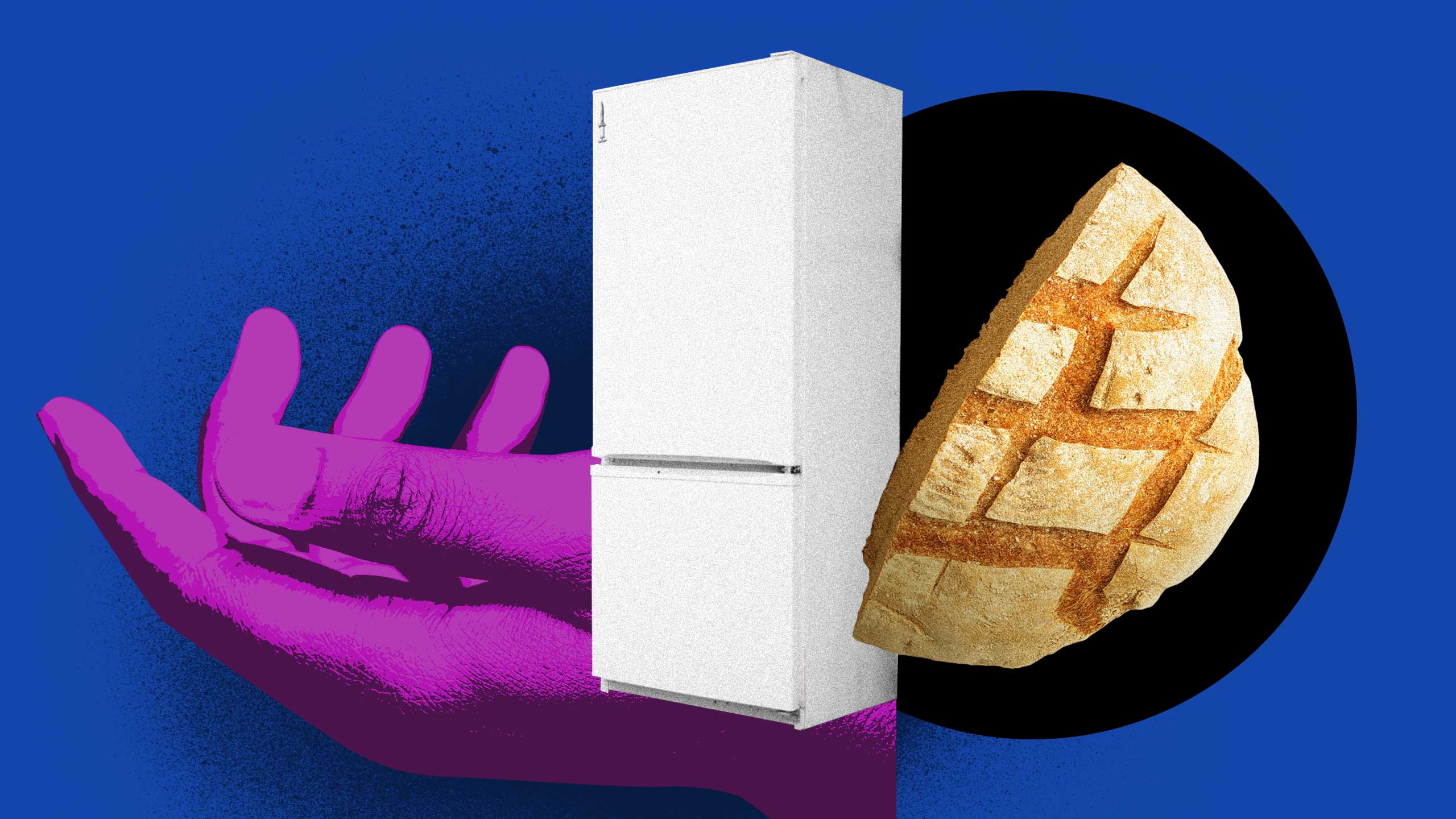Desiree Joy Frias has been on both sides of food distribution for people facing food insecurity. When she gave birth in March 2020, South Bronx Mutual Aid helped her stay safe as the pandemic spread. “I was trapped in my house with my newborn, husband, 84-year-old grandmother on immunosuppressant drugs and I had just had a C-section,” Frias says. “Strangers brought me groceries, my grandmother’s medication, baby items when we couldn’t go out safely.”
But Frias, a queer Afro-Latinx organizer, also works as a campaign director of The People’s Bailout, a Bronx-based organization advocating for housing, health care and food needs. Every day, she sees the stigma around food insecurity. “Everyone feels hunger, so why do we shame people for asking for food?” she asks. “Make them wait in line for four hours, show an ID card, meet criteria?”
Frias’ work challenges the current “charity models” of food distribution, including canned food drives, soup kitchens and food pantries. “There’s enough food for everyone,” she says. “Why do we need to give people a bag of food without letting them choose what goes in it?”
According to Frias, food insecurity is a community problem that disproportionately affects LGBTQ2S+ people. Among queer and trans adults in the United States, about 27 percent have experienced some form of food insecurity, according to a 2017 Gallup Daily Tracking Survey; that’s 10 percent higher than the general population. That rate rises to 31 percent when it comes to lesbian, bisexual and trans adult women, and it’s even higher among Black LGBTQ2S+ adults, with 37 percent experiencing food insecurity. Meanwhile, a June 2020 Statistics Canada report shows that 14.6 percent of Canadians had experienced food insecurity in the 30 days prior to the report, and recent research suggests bisexual Canadians are three times more likely to be food insecure than their heterosexual counterparts.
These numbers have only worsened during the pandemic. That’s why queer-centred organizations like Frias’ have stepped up to ensure that members of their communities stay fed. From informal mutual aid groups to Facebook communities and local non-profits, more individuals are investing in the idea of hyperlocal food distribution in LGBTQ2S+ communities. Here’s how you can help in your own community:
Ask what logistical support is needed
Jessica L’Whor is a queer, non-binary drag performer and the director of the non-profit We Are Family Colorado. While she partook in food redistribution work in high school and college—and had personally experienced food insecurity herself—she didn’t realize how widespread the problem was until the start of the pandemic. That’s when she decided to get involved in the work again. She was tired of “making excuses as to why I couldn’t be out there helping people, especially during a pandemic,” she says.
“Talk to people in your community, encourage your friends to get involved with you and try to make the effort to simply be there for other people in need.”
If you want to get involved, there are ways to do so in the logistics department of mutual aid and community food distribution efforts, L’Whor says. There are a lot of different ways to get involved, even if you don’t have previous experience. You can promote events associated with groups working in food distribution, sign up to help with distribution of food or even just reach out to local groups that provide these services to directly ask how you can help, she says.
As COVID-19 continues to spread, the need for food delivery services has been especially exacerbated for those who are immunocompromised, people who have been exposed and folks who are sick and trapped at home in need of door-side support. “Talk to people in your community, encourage your friends to get involved with you and try to make the effort to simply be there for other people in need,” L’Whor says.
Start a refrigerator
From New York City to Milwaukee, refrigerators have been popping up in alleys and outside of restaurants. These fridges offer food access without shame and with no strings. Frias’ family has both helped stock these fridges and been supported by them. She likes this model and wants to see one on every block. “[There’s] no one to ask permission [from]. No one to police how much or how little they take or leave,” she says.
The fridges are stocked with both fresh and prepared foods. “There are so many houseless people right now that I want to make sure they have prepared foods as an option in their community fridge, not just ingredients,” Frias says.
If you want to start, operate and stock a fridge in your own community, Frias recommends taking a look at this guide created by In Our Hearts, the New York City-based refrigerator network. The guide offers advice on everything from building a team to stocking the refrigerator to getting the word out.
Donate food
When COVID-19 forced people to stay home and the working-class people in his community began to lose their jobs, Robert Salcido Jr. got to work. The executive director of San Antonio’s Pride Center, he says the phones were ringing: The community asked for support to buy food, toiletries and pay for utilities. The city’s services were overrun with need, and that wasn’t all. “We also wanted to ensure that people who didn’t feel comfortable or safe asking for assistance through traditional means had a place to turn to,” he says.
On issues of food insecurity among LGBTQ2S+ folks, Salcido offers this advice: “Go through your own pantry and cabinets, find unexpired items that your family isn’t using and donate those items,” he says. “There are many creative ways to help that are not financially straining to our already stretched household budgets.”
“There are many creative ways to help that are not financially straining to our already stretched household budgets.”
One of those creative ways to help involves “rescuing food,” like asking your local supermarket if they have food to give, says Frias. “Nothing replaces walking in and asking,” she says. “I walked to the back of a major chain in my neighbourhood and asked what they do with the food they can’t sell anymore. They told me they destroy it.” Then, she says, the store admitted that, the day before, they had destroyed 14,000 pounds of salmon that had reached its sell-by date.“I gave them my number and asked them to call me instead next time,” Frias says. Since then, she says she’s already rescued 800 pounds of ground beef, tilapia and chicken in just two trips.
Cook and share with your community
Hali Diecidue, a butch, transgender person and founder of Boston’s Village Bread, takes feeding people directly to another level. The Village Bread focuses on giving back and offering bread to people who can’t afford it; for every loaf sold, another goes to a local shelter.
It started when Diecidue fell in love with baking artisan bread. “The ability to make good artisan bread takes a lot of practice and, as much as I hate to admit it, even a great lover of bread like myself can only eat so much bread,” they say.
At first, they began to gift the bread they baked to their friends and neighbours; they could afford to pay for it. “I wanted to give my bread to people who actually might not be able to afford high-quality—and by that, I mean ingredient content, as well as the [artisan] creation piece—food,” Diecidue says.
Making an extra portion of your dinner and offering it to a community member is an easy way to start fighting food insecurity on a hyper-local level. You can either post on Facebook, bring it to a local refrigerator or ask your neighbours.
“It’s so easy to double a recipe. It does not cost that much more and adds zero extra work,” Diecidue says. “Do it. Give one away. You never know who is in need or who simply needs something special.”
Correction: January 11, 2021 12:28 pmThis story has been updated to correct the name of The People’s Bailout, incorrectly noted as A People’s Bailout in a previous iteration.


 Why you can trust Xtra
Why you can trust Xtra


